How to assess the effectiveness of a sargassum barrier?
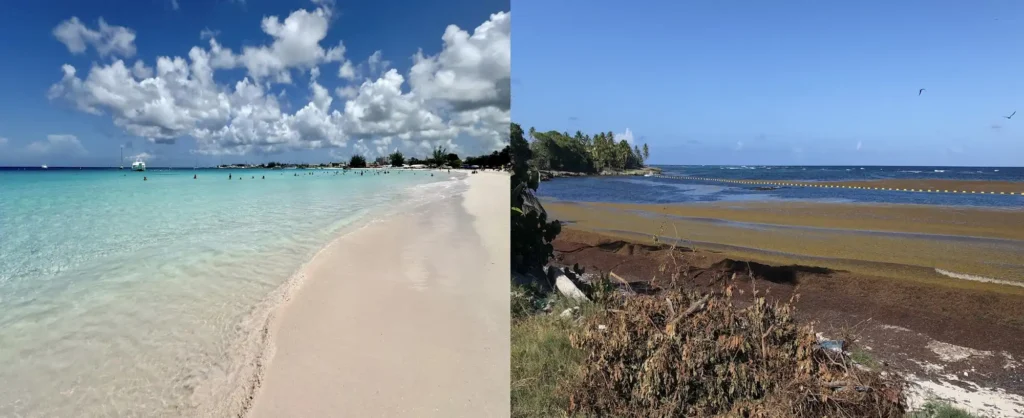
Lying on the beach under the Caribbean sun, you have plenty of time to observe the barriers that your hotel or municipality has installed to protect your beach from massive arrivals of sargassum seaweed. You know these barriers are necessary to prevent an economic, health, and ecological disaster, but since your beach is still covered with seaweed, you’re wondering: is this barrier really effective?
Sargassum Monitoring® has investigated to help you observe and better understand.
To begin, here’s the legend of the colors and symbols we used:
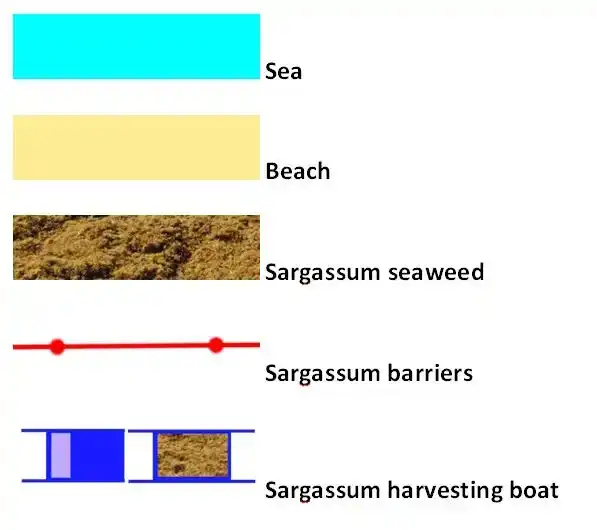
Image 1/ No Sargassum

There are no algae on the beach or behind the barrier simply because there is no sargassum in the water. This doesn’t mean the barrier is effective; it just means there’s no sargassum in sight. So, enjoy it!
Image 2/ 0% Effectiveness

When there are regularly tons of sargassum on the beach and none behind the sargassum barrier, you can deduce that the barrier intended to block the sargassum is not effective at all !
Image 3/ 50% Effectiveness

When there is regularly as much algae on the beach as there is behind the sargassum barrier, you can deduce that this type of barrier is 50% effective.
Image 4/ 95% Effectiveness

When the sargassum barrier regularly blocks a large amount of sargassum, and only a few clumps end up on the beach, you can deduce that this type of barrier is 95% effective. The beach is almost free of algae, and you can clearly see the algae behind the barrier.
Image 5/ 100% Effectiveness
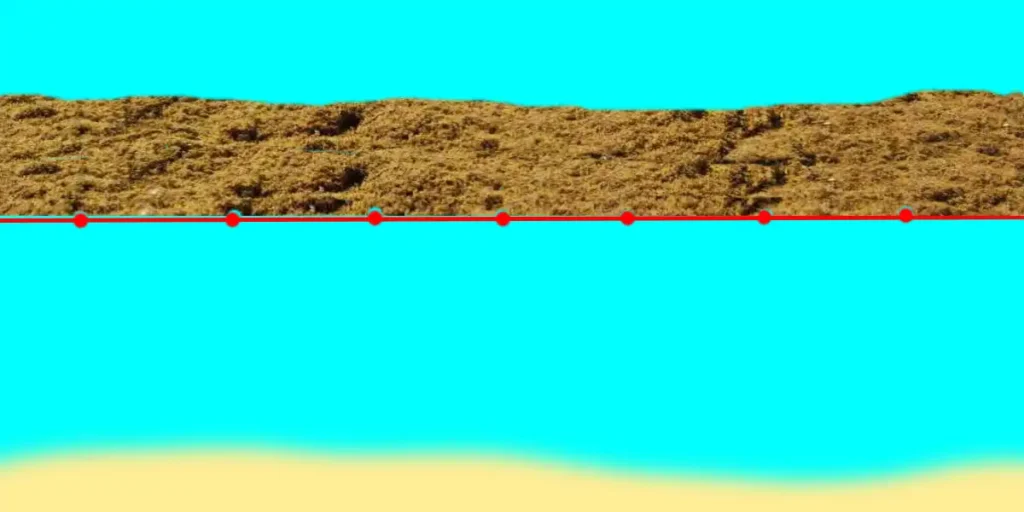
When the sargassum barrier blocks all the incoming algae, you can deduce that this type of barrier is 100% effective. In this case, the beach is pristine, and you can clearly see the algae behind the barrier. Wake up, this model doesn’t exist, and few seaweeds on a beach are completely normal !
Image 6/

When a barrier is completely ineffective, whether you place 1, 2, or 3 rows, it will remain completely ineffective. You’re just cluttering your view even more while making 1, 2, or 3 times the unnecessary expenses.
Here are some photos of the different types of sargassum barriers used in the Caribbean.
Blocking or Deflecting Barriers?
While for years there was no distinction in floating sargassum barriers, the concept of deflecting barriers has recently emerged. We asked a manufacturer, an expert in this field for over 25 years, about this. His answer is clear: in reality, it doesn’t exist. All barriers can be either blocking or deflecting, depending on how they are installed !
Barrier installed to block sargassum :

Once blocked, the sargassum seaweed must be regularly collected by a harvesting boat.

Barrier installed to deflect sargassum :
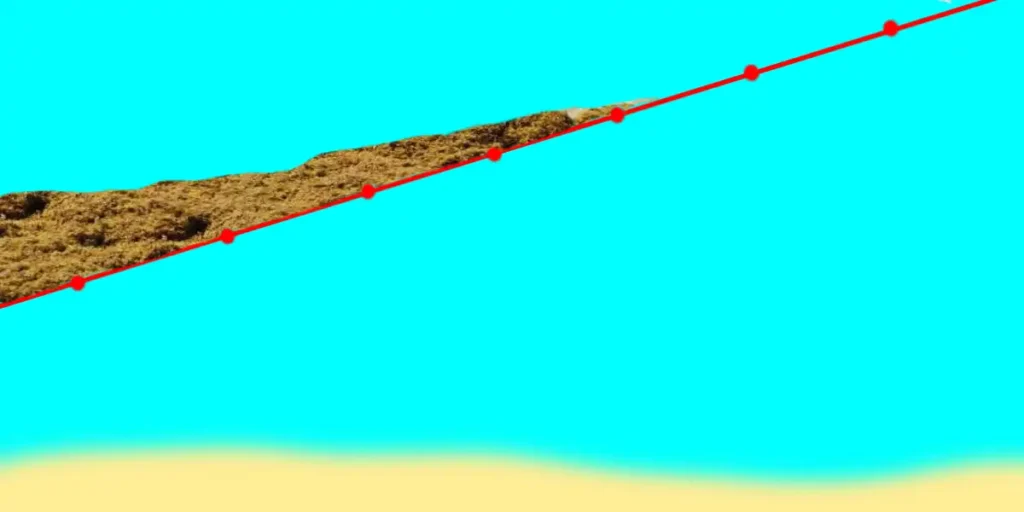
In this case, the sargassum is directed to a “sacrificed” area where it can be collected from the shoreline.
The Necessity of Installing Sargassum Barriers
Since 2011, sargassum, which naturally drifted across the ocean, has grown excessively, regularly invading the coastlines of more than 30 countries. Although the exact cause of this overgrowth is still unknown, it’s clear that this invasion is no longer a natural phenomenon, no longer “mother nature”.
Sargassum barriers aren’t just installed to give tourists a pristine beach; they also serve to prevent the coastal ecosystem from being completely wiped out.
When the geographical conditions allow it, installing a barrier is necessary:
- – They prevent sargassum from washing ashore and dying on the coastline, which is when it releases toxic gas (H2S). As it decomposes, it releases heavy metals (arsenic, cadmium, etc.) that permanently pollute the soil and groundwater. The decomposing algae also smother marine life, flora, and coral reefs.
- – Floating barriers help keep the sargassum at sea, where it remains alive. At this point, it must be harvested by boat, either to be released back into the ocean or recycled.
- – Thanks to these barriers, sargassum can be collected at sea without damaging the beach or removing sand. Sea turtles can reach their nesting sites and return to the ocean without the risk of dying on the beach, entangled in tons of algae.
Good sargassum barriers do not block marine life. Contrary to popular belief, barriers with fine mesh do not trap fish.
- – With effective sargassum barriers, there’s no longer a need for heavy harvesting machines to repeatedly traverse the beach—a noisy, sometimes dangerous, and often destructive process. Many photos document the erosion of coastlines in the Caribbean.
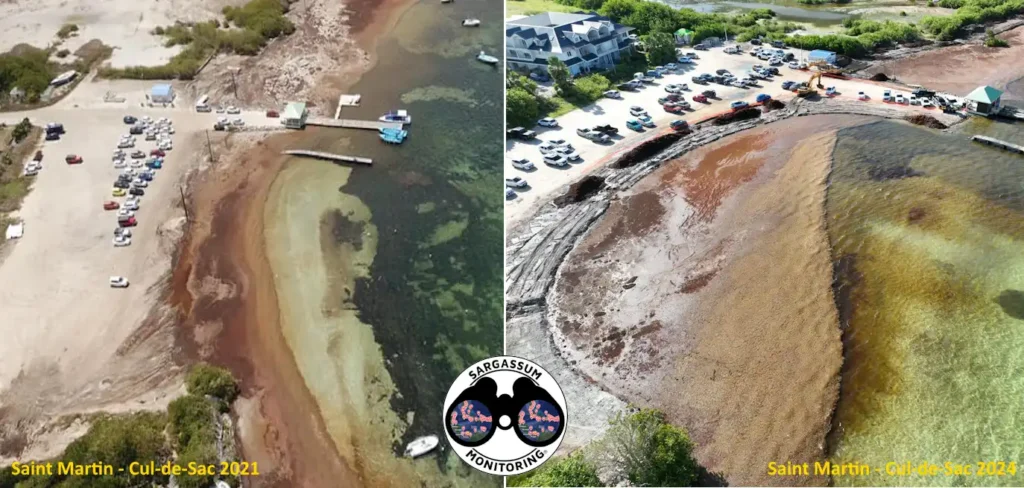
@ Souali’drone
Of course, lying on the beach facing the sea, with your view and swimming area obstructed or spoiled by unsightly sargassum barriers, is not what you expected in the tropics. Fortunately, some professionals have taken aesthetics into account, using material colors that blend into the landscape. They also offer barriers that can be installed far enough offshore to avoid disrupting the idyllic view of your vacation.
Acquiring effective, safe, durable, and aesthetically pleasing sargassum barriers is a real challenge for hotels and governments that genuinely want to protect the environment and satisfy the millions of visitors to the 30 countries affected by the sargassum seaweed invasion. Let’s not forget that the investment is significant, and defective materials will quickly end up in landfills.

Acquiring good barriers is one thing, but the installation should not be taken lightly. It must be planned and executed by true professionals who will carefully study the area to be protected, the currents, and the seabed to optimize performance while minimizing the ecological impact.
Obviously, after 8 years of observing and reporting sargassum strandings 7 days a week at Sargassum Monitoring®, we have our own opinions about the models tested and implemented.
To conclude on the subject ,
Sargassum Monitoring® encourages purposeful vacations. Tourists and residents of impacted areas:
- – Regularly share your beach photos with sargassum with us.
- – Share your experiences and opinions on the barriers and other measures implemented on your beach.
- – Join Sargassum Monitoring®, the world’s #1 Citizen Science Sargassum organization!
SEND YOUR PHOTOS TO OUR SOCIAL MEDIA !
You are citizen science; your contributions genuinely advance science and technology. To effectively protect our environment, we are doing everything we can to encourage greater participation. Very soon, a new tool will be available to make this even easier for you.
Thank you in advance,
The Sargassum Monitoring® team, dedicated volunteer experts at your service.
